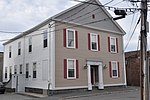Flanley's Block
Buildings and structures in Wakefield, MassachusettsCommercial blocks on the National Register of Historic Places in MassachusettsCommercial buildings completed in 1895National Register of Historic Places in Wakefield, MassachusettsRenaissance Revival architecture in Massachusetts

Flanley's Block is a historic commercial building at 349–353 Main Street in Wakefield, Massachusetts, US. Built about 1895, it is a well-preserved local example of late 19th-century Italianate commercial architecture. The building was listed on the National Register of Historic Places in 1989.
Excerpt from the Wikipedia article Flanley's Block (License: CC BY-SA 3.0, Authors, Images).Flanley's Block
Main Street,
Geographical coordinates (GPS) Address Phone number Website Nearby Places Show on map
Geographical coordinates (GPS)
| Latitude | Longitude |
|---|---|
| N 42.504444444444 ° | E -71.071944444444 ° |
Address
Lucius Beebe Memorial Library
Main Street 345
01880
Massachusetts, United States
Open on Google Maps











